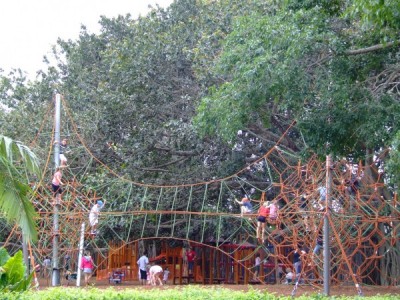The Benefits of Good Landscape Design: Education Facilities
Dependent on whether you are looking for a combination of play and nature based learning or outdoor learning in a constructed nature there are a number of key elements to consider

Landscape fulfils two essential roles in children’s lives and education; as a place of PLAY and as a place to experience NATURE. In today’s society, both of these things are diminishing or being challenged. Why is this? And why is it a problem?
PLAY
Experts say that: “we are grieving the loss of traditional forms of play that we used to consider a birthright – like making a cubby or mud pies in the garden. Play is compromised, because children’s lives are so controlled….as a by-product of the sophisticated world that we live in and the environment of test taking.” (Jan Deans, Director of the University of Melbourne’s Early Learning Centre – The Sunday Age, October 2010).
Technology is king. So much play involves the use of screens whether it be ipods, ipads, PC’s, games consoles. Children are not building or practicing crucial social skills such as negotiation.
With changing societal values and a changing urban structure – larger houses and smaller gardens – other than the occasional family holiday, there is an absence of nature from most children’s lives today. Add to this the rapidly urbanizing population in Australia and loss of natural habitats and biodiversity due to urban growth, it makes for a pretty dire situation. We are losing the opportunity to be able to play in nature.
Children spend over 30 hours per week at school. But there is an increased obsession with safety and minimizing risk and it is limiting playgrounds to gross motor activities and manufactured play equipment.
It is a problem because the benefits of play are well understood:
- There are the obvious benefits for physical health and obesity
- Children learn social and life skills through play
- Quality play involves the whole child: gross motor, fine motor, senses, emotion, intellect, individual growth and social interaction
NATURE
The problem is exacerbated by the concern today that children are also suffering from ‘nature deficit syndrome’. Again this is largely due to our rapidly urbanising communities, which is leading to a loss of natural or even green environments, the lure of technology taking preference over going out to explore the natural world and parental fears, brought on by societal concerns, about kids doing this.
Traditionally, our schools yards have not helped. The typical school yard is one of asphalt and steel playground structures. While both inside and outside the classroom lives are much more structured and supervised, with less time to explore nature even where available.
But there is the emerging concept of eco-psychology: the idea that humans have an affinity with their environment. And research shows that our environment affects both our physical and mental health.
Recent findings suggest:
- Children who regularly play in natural environments have cognitive development 2 years more advanced that those who don’t
- Primary school children who undergo nature-based programs show improvement in their concentration, communication with peers, creative problem solving, creativity and cognitive ability
- Concern for the environment is based on affection for nature that only develops with regular and unchecked contact with it
- Natural playgrounds have academic benefits because outdoor play fosters a sense of wonder that serves as a motivator for life long learning
Top Emerging Trends
So what are some of the trends that schools can look to integrate into their plans?
- Kitchen garden schemes – Kitchen Garden Schools commit to a dynamic and innovative model that sees kitchen and garden classes run weekly, enabling skills-based learning that extends across the entire school curriculum. The diversity of locations of Kitchen Garden Schools – from Coober Pedy in the outback, to Alawa in the tropics, to beachside Bondi – means that each school community has its own designs, challenges and successes.
- Introduction of natural elements in school grounds – eg wetlands, woodlands etc. These are of environmental benefit but their true value emerges only through their integration into the school’s overall educational program
- Wireless technology with portable devices that can free a wider range of spaces for learning, extending beyond the physical building into the surrounding landscape
- Discovery Gardens – Children value unmanicured places and the adventure and mystery of hiding places and wild, spacious, uneven areas broken by clusters of plants
- Play pods – Play for Life Australia has conducted trials of the pods started in Britain and the US 5 years ago and has found them to improve kids decision making, create more inclusive playgrounds and reduce playground incidents.
Top Landscape Design Tips
Dependent on whether you are looking for a combination of play and nature based learning or outdoor learning in a constructed nature there are a number of key elements to consider:
- Look to use landscape & vegetation as the play setting
- Create an informal & naturalistic environment to stimulate free play & discovery learning
- Ensure seamless integration between indoor and outdoor
- Design on different levels and look to include plenty of nooks and crannies
- Use natural materials, water, sand, stone, wood, plants set within a robust structure
- Build outdoor teaching spaces with fixed seating and shade structures
Landscape is important as a place for PLAY but most importantly as a place to play in NATURE.
There is an opportunity for schools to play a vital part in restoring children’s access to play in nature, with measurable, cognitive development improvement. Schools of the future that can offer this experience will have a marked advantage over those that don’t.
